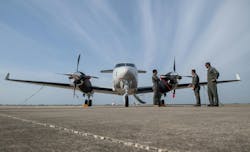Textron to build 26 T-54A twin-engine aircraft and avionics to help pilots learn to fly multi-engine planes
PATUXENT RIVER NAS, Md. – U.S. Navy flight training experts are boosting the Navy's inventory of multi-engine training aircraft with $276.8 million order last week to Textron Aviation Inc. in Wichita, Kan., for 26 T-54A twin-engine turboprop aircraft.
Officials of the Naval Air Systems Command at Patuxent River Naval Air Station, Md., are asking Textron Aviation to build the 26 T-54A aircraft, and provide spare parts, and support to help train U.S. Navy, Marine Corps, and Coast Guard pilots in multi-engine aircraft.
The T-54A is based on the Beechcraft King Air 260 nine-seat commercial aviation twin-engine turboprop. The venerable King Air was developed by Beechcraft in the 1960s before the company was acquired by Textron in 2014. Textron also manufactures Cessna aircraft.
Based on Beechcraft King Air 260
The Navy received the first two operational T-54A twin-engine aircraft last spring at Corpus Christi Naval Air Station, Texas, which is home to Training Air Wing Four of the Navy's Chief of Naval Air Training. The T-54A is replacing the aging T-44C Pegasus aircraft.
The T-54A, which has a pressurized cockpit with side-by-side seating and a jump seat, will provide advanced instrument and asymmetric engine handling training to student naval aviators who are learning to fly multi-engine aircraft.
The plane can capture data for conditioned-based maintenance plus that tracks aircraft health over time for improved maintenance planning. The T-54 has the latest avionics and navigational updates, including a state-of-the-art cockpit with technology advances in the flight management system.
The Navy may buy as many as 64 T-54 aircraft, for which deliveries are scheduled through 2026. The unarmed T-54A is the aircraft portion of the Navy's multi-engine training system (METS).
Updated avionics
The aircraft will include an updated avionics suite and advanced automation capabilities to enhance naval aviator competencies and better prepare students for the aircraft they will fly in the fleet. The T-54A will provide advanced instrument and asymmetric engine handling training to student naval aviators selected for multi-engine fleet communities within the U.S. Navy, Marine Corps and Coast Guard, as well as select U.S. allies.
Using a skills-based approach to training with just-in-time methodology that incorporates modern technology, this new aircraft opens a door for enhanced training opportunities so Fleet Replacement Squadrons can spend less time on foundational skills and focus more on mission requirements for today’s pilots. T-54A technology will also capture data that allows for Conditioned-Based Maintenance Plus, a capability that enables the Navy to trend aircraft health over time to facilitate improved maintenance planning and efficiency.
The T-54A is expected to be in service for about 30 years. The plane has two Pratt & Whitney Canada PT6A-52 engines; is 43 feet, 10 inches long; 14 feet, 10 inches high; has a 57-foot, 11-inch wingspan; has a maximum takeoff weight of 12,500 pounds; can fly as fast as 259 knots; can fly as high as 35,000 feet; and has a range of 1,640 nautical miles.
On this order Textron Aviation will do the work in Wichita, Kan.; and Corpus Christi, Texas, and should be finished by September 2026. For more information contact Textron Aviation online at https://txtav.com.
About the Author
John Keller
Editor-in-Chief
John Keller is the Editor-in-Chief, Military & Aerospace Electronics Magazine--provides extensive coverage and analysis of enabling electronics and optoelectronic technologies in military, space and commercial aviation applications. John has been a member of the Military & Aerospace Electronics staff since 1989 and chief editor since 1995.
